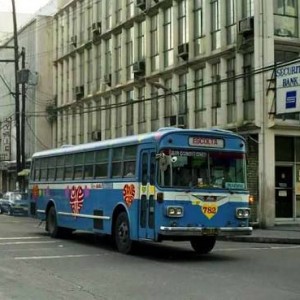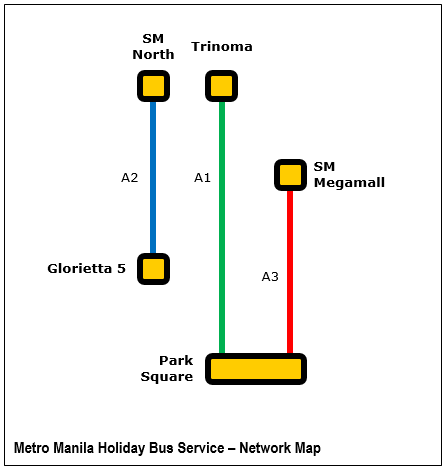Filipinos are too quick to slam the efforts of the Metro Manila Development Authority (MMDA) and the Land Transportation Franchising and Regulatory Board (LTFRB) to provide an alternative public transport option to Metro Manilans. The “Holiday Bus Service” is actually a good idea. Half-baked perhaps, but a good one that possibly needs more time in the oven.
The Holiday Bus Service is a simple three-route network at the moment, but uses principles applied in modern public bus transport networks in advanced countries. The network links five main terminals — two in the uptown Metro Manila suburb of Quezon City at SM North EDSA and Trinoma (North EDSA), one midtown in Pasig City at the SM Megamall, and two downtown in Ayala Center, Makati City at Glorietta 5 and Park Square Terminal. Route A1 links the Trinoma terminal with the Makati Park Square Terminal, Route A2 links SM North EDSA terminal with the Glorietta 5 terminal, and Route A3 links the SM Megamall terminal with the Park Square Terminal.

The now-defunct ‘Love Bus’ service run by Manila in the 1970s and 1980s was ahead of its time.
| SUPPORT INDEPENDENT SOCIAL COMMENTARY! Subscribe to our Substack community GRP Insider to receive by email our in-depth free weekly newsletter. Opt into a paid subscription and you'll get premium insider briefs and insights from us. Subscribe to our Substack newsletter, GRP Insider! Learn more |
In this regard the Holiday Bus Service of the MMDA and LTFRB is a promising “innovation” to Metro Manila’s dysfunctional road-based public transport system. As a government service, it should be allowed to operate at a loss if necessary. That said, it does not even have to. If the strategy is to get more people out of private cars and onto public transport, then its current price structure could be retained to restrict its patrons to a crowd that, shall we say, appeals to the predominantly car-owning Conyos of Manila and encourage them to leave their “dangerous” Mitsubishi Monteros at home where they belong during weekdays.

In its current form, Manila’s Holiday Bus Service could be the embryo of a long-overdue modern bus transport system.
For that matter, consider that one of the developers of this service is the LTFRB which, among other things, is the regulatory body that governs allocation of franchises and routes to public transport service providers. This means that the LTFRB even on its own has the power to unilaterally improve the competitive standing of the Holiday Bus Service vis-a-vis all the rest of the rogue services operating in Metro Manila. All the LTFRB needs to do is to start cancelling competing jeepney and bus services and replace these with similar scheduled limited-stop services, in the process expanding the modern road-based bus network.
Indeed, only with the complete abolition of the current “boundary”-based fare structure used by private transport operators in key Metro Manila transport routes and replacing these with services composed of vehicles driven by professional drivers on fixed salaries will the rot in Metro Manila’s public transport network be eventually managed down. At the moment, chaos reigns because public utility vehicle drivers are incentivised by having most of their income tied to a commission on the day’s fare collection. This drives the sorts of abusive behaviour in bus and jeepney drivers that Metro Manila commuters put up with today.
Perhaps the key to modernising Metro Manila’s bus system is at hand. All we need to do is be patient and give the Holiday Bus Service a chance.
[Thumbnail photo courtesy PhilStar.]
benign0 is the Webmaster of GetRealPhilippines.com.
I am definitely NOT pro-Marcos, but as someone who lived in Metro Manila in the 1970s, I know that Mel Mathay, Metro Manila Commissioner, did some really good work – the Love busses, the double deckers and stuff, but as usual for any Philippine government even they lacked the follow-through to make more out of it… even the dictatorship was very Filipino and palpak.
here’s what i’m thinking:
Jeepneys need to be gradually eliminated yearly while these new bus service also increases. the private franchises should be converted to product making. their own PUV drivers will be automatically converted to factory workers at this point. small/mid franchises can create a partnership if they can’t stand alone. old jeepneys/buses can be refurbished and sold to 4th world countries so we can help their economy.
Such products that will be made will compete internationally. I may have them make the first Philippine Car. Rechargeable battery na kaagad wala nang gas.
>> sold to 4th world countries
um .. haven’t you noticed that third-world countries already send their shit to the Philippines?
And why on earth would you attempt to literally reinvent the wheel? There are companies all over the world making excellent electric vehicles cheaper and better than the Philippines ever could.
I don’t know why the country is so obsessed with being “independent”. That hasn’t worked out so well for N Korea, has it?
I don’t believe the Bus Service will ever be a solution to the traffic problems of our country.
Most of those cars sold in the Philippines, are second or third hand cars. They are refurbished, and sold as new.
Only by a rail system, can we move many people, from place to place. But, our rail system is obsolete; not well maintained; not upgraded , from time to time. Aquino and Abaya, the two stooges , assured us that the rail system is working properly.
Obsolete? As far as I know, the Philippines doesn’t HAVE a rail network.
The US economy was built upon rails. It is the cheapest, fastest, and safest way of moving freight and people. With Chinese suppliers now making high-quality track and rolling stock, it’s cheaper than it ever was. There’s no excuse for the Philippines not having a world-class rail network except for the usual one – laziness and theft of public funds.
For a pathetic city hemorrhaging in vehicular constipation, yeah this bus system could ease the pain a bit.
If the Japs didn’t let go of us so easily, all major islands would have already been linked by high-speed / undersea trains.
But of course we need to feed our good old Peenoy pride and show to the whole world we can “survive” on our own – and survive we did like resilient rats and cockroaches in damp stinking sewers.
Public transit situates us so that we are given license to accept what’s right in front of us, but will likely arouse our desire to compare our narrative to someone else’s, to give ourselves permission to speculate upon a person’s private space, or life, with no fear of recourse or punishment.